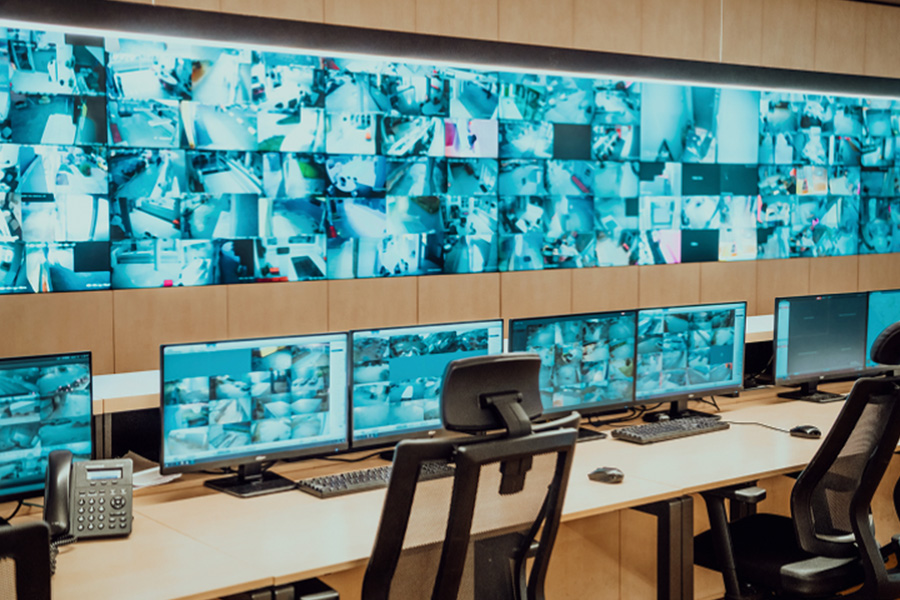Outfitting a security control room requires more than just installing screens and placing desks. Remember, these areas serve as the hubs of high-risk settings, including surveillance, critical infrastructure, transportation, and utilities. Therefore, selecting appropriate control room furniture and layout is integral in ensuring efficient, uninterrupted operations. After all, one tiny mistake in design or procurement can result in performance issues, safety risks, and long-term costs.
Discover four key missteps to avoid when setting up or upgrading a security control room.
1. Choosing Non-Ergonomic or Inflexible Control Room Furniture
Security control rooms are staffed 24/7, often involving rotating personnel who must remain alert and responsive over long shifts. One of the most common and costly mistakes is selecting furniture that lacks ergonomic consideration. Fixed-height desks, non-adjustable monitor mounts, and chairs without lumbar support contribute to operator fatigue, discomfort, and reduced situational awareness.
Control room furniture must then be specifically designed for mission-critical environments. This includes sit-stand consoles, adjustable-height work surfaces, and modular designs that accommodate different users.
Ignoring these needs can reduce productivity and increase occupational health risks. Operators who are uncomfortable or poorly positioned are more likely to miss critical events, especially during night shifts or prolonged monitoring tasks.
2. Overcrowding the Room with Equipment or Furniture
Some facilities overload the security control room with screens, servers, and redundant consoles in an effort to integrate every piece of surveillance technology. While well-meaning, this approach reduces usable space and limits airflow, often resulting in higher ambient temperatures, cluttered cabling, and a chaotic environment. Control room furniture should then be sized and placed with proper spatial planning in mind, allowing for clear sightlines, safe movement, and easy maintenance.
Overcrowding can also restrict the ability of personnel to work collaboratively, particularly during incident escalation. A well-designed layout with strategically placed workstations, equipment racks, and storage compartments prevents operational bottlenecks and ensures a clean, professional workspace. Skimping on layout planning leads to long-term inefficiencies and poor operator performance.
ALSO READ: How to Optimise Your Control Room Setup for 24/7 Operations
3. Neglecting Future-Proofing and Scalability
Security environments are dynamic: technology evolves, risks change, and surveillance coverage often expands. A significant error during outfitting is choosing furniture or setups that are not scalable or adaptable. This approach includes using built-in consoles that cannot be reconfigured, limited cable management systems, and outdated power distribution infrastructure.
Proper control room furniture should allow for future growth and reconfiguration. Modular consoles, integrated power and data management, and scalable rack systems enable easy upgrades without requiring full room redesigns. A piece of furniture that cannot support additional screens, operator roles, or new technologies becomes obsolete quickly, leading to repeated capital outlays. Forward-looking planning must be incorporated at the design stage.
4. Overlooking Compliance, Standards, and Operator Workflow
Finally, outfitting a security control room without adhering to industry standards or understanding operator workflow can compromise its overall effectiveness.
Furniture must comply with standards such as ISO 11064 for control room design, which addresses layout, ergonomics, and environmental factors. Additionally, ignoring the actual duties of the operators, such as their need for direct access to communication systems, emergency alarms, or video feeds, can result in poor furniture placement and suboptimal performance. Remember, furniture must support not just physical ergonomics but also workflow efficiency. This approach includes integrating critical controls into the console layout, ensuring visibility to priority monitors, and placing frequently accessed tools within arm’s reach.
Non-compliance and poor workflow design lead to operational delays and increased response times during emergencies.
Conclusion
Avoiding these four common mistakes: poor ergonomics, overcrowding, lack of scalability, and neglecting standards, is essential to building an efficient and responsive security control room. Investing in the right control room furniture and taking a systems-level approach to layout planning ensures your facility operates without compromise.
Visit Datumstruct CFS and let us ensure your security control room meets modern operational demands.

